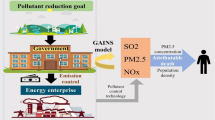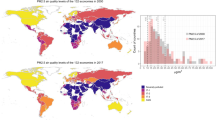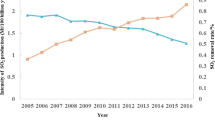Abstract
Air quality in China is increasingly improving, but the situation facing the atmosphere environment is still dire. Regional atmospheric environmental problems characterized by PM2.5 pollutants are becoming increasingly prominent, especially in the Jing-Jin-Ji (3J) region. This study employs the generalized Divisia index approach to decompose the factors that influence the changes of PM2.5 emission in the 3J region. It is divided into 8 factors: scale effect of regional economy, scale effect of regional energy consumption, scale effect of investment in treatment of environment pollution (ITEP), technology effect of energy efficient utilization, technology effect of clean energy utilization technology, the intensity effect of regional green economic development, the intensity effect of investment in treatment of regional PM2.5 emission, and the intensity effect of regional environmental regulation. To identify the vital driving force of the change of PM2.5 emission, the contribution of each driving factor of PM2.5 emission variation is analyzed. The results show that the factors affecting the change of PM2.5 emission are almost the same, but the contribution of each factor is apparently different in the 3J region. The level of regional economic development and the scale of energy consumption promoted the increase of PM2.5 emission in the region. The growth of PM2.5 emission can be effectively controlled by green economic development intensity, energy clean utilization technology, environmental regulation intensity, and the intensity of investment in treatment of PM2.5 emission. Energy efficiency has a slight effect on the changes of PM2.5 emission. ITEP has a negative effect on the changes of PM2.5 emission. In the future, the 3J region needs to optimize the structure of ITEP further and implement the refinement and precision of pollution treatment. Moreover, it also needs to promote the development of energy clean and efficient use of technological innovation to drive PM2.5 emission reduction.




Similar content being viewed by others
Data Availability
The datasets used and/or analyzed during the current study are available from the corresponding author on reasonable request.
References
Ang BW (2004) Decomposition analysis for policymaking in energy: which is the preferred method? Energy Policy 32(9):1131–1139
Ang BW (2005) The LMDI approach to decomposition analysis: a practical guide. Energy Policy 33(7):867–871
Ang BW (2015) LMDI decomposition approach: a guide for implementation. Energy Policy 86:233–238
Ang BW, Zhang FQ (2000) A survey of index decomposition analysis in energy and environmental studies. Energy 25(12):1149–1176
Cai S, Wang Y, Zhao B, Wang S, Chang X, Hao J (2017) The impact of the “air pollution prevention and control action plan” on PM2.5 concentrations in Jing-Jin-Ji region during 2012–2020. Sci Total Environ 580:197–209
Chen J, Wang S, Zhou C, Li M (2019) Does the path of technological progress matter in mitigating China’s PM2.5 concentrations? Evidence from three urban agglomerations in China. Environ Pollut 254:113012
Chen X, Li F, Zhang J, Zhou W, Wang X, Fu H (2020) Spatiotemporal mapping and multiple driving forces identifying of PM2.5 variation and its joint management strategies across China. J Clean Prod 250:119534
Cheng Z, Li L, Liu J (2020) The impact of foreign direct investment on urban PM2.5 pollution in China. J Environ Manag 265:110532
Cole MA, Elliott RJR, Shimamoto K (2005) Industrial characteristics, environmental regulations and air pollution: an analysis of the UK manufacturing sector. J Environ Econ Manag 50(1):121–143
Ding Y, Zhang M, Chen S, Wang W, Nie R (2019) The environmental Kuznets curve for PM2.5 pollution in Beijing-Tianjin-Hebei region of China: a spatial panel data approach. J Clean Prod 220:984–994
Dong F, Yu B, Pan Y (2019) Examining the synergistic effect of CO2 emissions on PM2.5 emissions reduction: evidence from China. J Clean Prod 223:759–771
Editorial (2019) Cleaner air for China. Nat Geosci 12(7):497–497
Fang D, Hao P, Yu Q, Wang J (2020) The impacts of electricity consumption in China’s key economic regions. Appl Energy 267:115078
Feng Y, Ning M, Lei Y, Sun Y, Liu W, Wang J (2019) Defending blue sky in China: effectiveness of the “air pollution prevention and control action plan” on air quality improvements from 2013 to 2017. J Environ Manag 252:109603
Guan D, Su X, Zhang Q, Peters GP, Liu Z, Lei Y, He K (2014) The socioeconomic drivers of China’s primary PM2.5emissions. Environ Res Lett 9(2):024010
Hoekstra R, van den Bergh JCJM (2003) Comparing structural decomposition analysis and index. Energy Econ 25(1):39–64
Li G, Fang C, Wang S, Sun S (2016) The effect of economic growth, urbanization, and industrialization on fine particulate matter (PM2.5) concentrations in China. Environ Sci Technol 50(21):11452–11459
Li N, Zhang X, Shi M, Hewings GJD (2019) Does China’s air pollution abatement policy matter? An assessment of the Beijing-Tianjin-Hebei region based on a multi-regional CGE model. Energy Policy 127:213–227
Li B, Han S, Wang Y, Wang Y, Li J, Wang Y (2020) Feasibility assessment of the carbon emissions peak in China’s construction industry: factor decomposition and peak forecast. Sci Total Environ 706:135716
Liu S, Chu Y, Hu J (2020) Clean air actions and air quality improvements — Beijing-Tianjin-Hebei and surrounding areas, China, 2013−2019. China CDC Wkly 2(23):418–421
Lyu W, Li Y, Guan D, Zhao H, Zhang Q, Liu Z (2016) Driving forces of Chinese primary air pollution emissions: an index decomposition analysis. J Clean Prod 133:136–144
Miao Z, Baležentis T, Shao S, Chang D (2019) Energy use, industrial soot and vehicle exhaust pollution—China’s regional air pollution recognition, performance decomposition and governance. Energy Econ 83:501–514
Niu T, Yao X, Shao S, Li D, Wang W (2018) Environmental tax shocks and carbon emissions: an estimated DSGE model. Struct Chang Econ Dyn 47:9–17
Shao S, Liu J, Geng Y, Miao Z, Yang Y (2016) Uncovering driving factors of carbon emissions from China’s mining sector. Appl Energy 166:220–238
Shi K, Shen J, Wang L, Ma M, Cui Y (2020) A multiscale analysis of the effect of urban expansion on PM2.5 concentrations in China: evidence from multisource remote sensing and statistical data. Build Environ 174:106778
Song X, Geng Y, Li K, Zhang X, Wu F, Pan H, Zhang Y (2020) Does environmental infrastructure investment contribute to emissions reduction? A case of China. Front Energy 14(1):57–70
Sun D, Fang J, Sun J (2018) Health-related benefits of air quality improvement from coal control in China: evidence from the Jing-Jin-Ji region. Resour Conserv Recycl 129:416–423
The Chinese Ministry of Ecology and Environment (2019) 2019-2020 comprehensive action plan for air pollution control during fall and winter in the Beijing-Tianjin-Hebei Region and nearby areas. Retrieved from http://www.mee.gov.cn/xxgk2018/xxgk/xxgk03/201910/t20191016_737803.html. Access 20 May 2020
The State Council of China (2013) Air pollution prevention and control action plan. Retrieved from http://www.gov.cn/zwgk/2013-09/12/content_2486773.htm. Access 20 May 2020
The State Council of China (2018) Three-year action plan to win the battle for a blue sky. Retrieved from http://www.gov.cn/zhengce/content/2018-07/03/content_5303158.htm. Access 20 May 2020
van Donkelaar A, Martin Randall V, Brauer M, Boys Brian L (2015) Use of satellite observations for long-term exposure assessment of global concentrations of fine particulate matter. Environ Health Perspect 123(2):135–143
van Donkelaar A, Martin RV, Brauer M, Hsu NC, Kahn RA, Levy RC, Lyapustin A, Sayer AM, Winker DM (2016) Global estimates of fine particulate matter using a combined geophysical-statistical method with information from satellites, models, and monitors. Environ Sci Technol 50(7):3762–3772
Vaninsky A (2014) Factorial decomposition of CO2 emissions: a generalized Divisia index approach. Energy Econ 45:389–400
Wang H, Lu X, Deng Y, Sun Y, Nielsen CP, Liu Y, Zhu G, Bu M, Bi J, McElroy MB (2019a) China’s CO2 peak before 2030 implied from characteristics and growth of cities. Nat Sustain 2(8):748–754
Wang K, Yin H, Chen Y (2019b) The effect of environmental regulation on air quality: a study of new ambient air quality standards in China. J Clean Prod 215:268–279
Wu X, Tan L, Guo J, Wang Y, Liu H, Zhu W (2016) A study of allocative efficiency of PM2.5 emission rights based on a zero sum gains data envelopment model. J Clean Prod 113:1024–1031
Wu W, Zhang M, Ding Y (2020) Exploring the effect of economic and environment factors on PM2.5 concentration: a case study of the Beijing-Tianjin-Hebei region. J Environ Manag 268:110703
Xie Q, Sun Q (2020) Assessing the impact of FDI on PM2.5 concentrations: a nonlinear panel data analysis for emerging economies. Environ Impact Assess Rev 80:106314
Xinhua (2019) China sets air quality target for Beijing-Tianjin-Hebei. Retrieved from http://www.xinhuanet.com/english/2019-10/16/c_138476499.htm
Xu B, Lin B (2018) What cause large regional differences in PM2.5 pollutions in China? Evidence from quantile regression model. J Clean Prod 174:447–461
Xu G, Ren X, Xiong K, Li L, Bi X, Wu Q (2020) Analysis of the driving factors of PM2.5 concentration in the air: a case study of the Yangtze River Delta, China. Ecol Indic 110:105889
Yan Q, Yin J, Baležentis T, Makutėnienė D, Štreimikienė D (2017) Energy-related GHG emission in agriculture of the European countries: an application of the Generalized Divisia Index. J Clean Prod 164:686–694
Yan D, Lei Y, Shi Y, Zhu Q, Li L, Zhang Z (2018) Evolution of the spatiotemporal pattern of PM2.5 concentrations in China – a case study from the Beijing-Tianjin-Hebei region. Atmos Environ 183:225–233
Yan Q, Wang Y, Baležentis T, Streimikiene D (2019a) Analysis of China’s regional thermal electricity generation and CO2 emissions: decomposition based on the generalized Divisia index. Sci Total Environ 682:737–755
Yan Q, Wang Y, Li Z, Baležentis T, Streimikiene D (2019b) Coordinated development of thermal power generation in Beijing-Tianjin-Hebei region: evidence from decomposition and scenario analysis for carbon dioxide emission. J Clean Prod 232:1402–1417
Yan D, Ren X, Kong Y, Ye B, Liao Z (2020) The heterogeneous effects of socioeconomic determinants on PM2.5 concentrations using a two-step panel quantile regression. Appl Energy 272:115246
Yang J, Song D, Fang D, Wu F (2019) Drivers of consumption-based PM2.5 emission of Beijing: a structural decomposition analysis. J Clean Prod 219:734–742
Yue H, He C, Huang Q, Yin D, Bryan BA (2020) Stronger policy required to substantially reduce deaths from PM2.5 pollution in China. Nat Commun 11(1):1462
Zhang Q, Zheng Y, Tong D, Shao M, Wang S, Zhang Y, Xu X, Wang J, He H, Liu W, Ding Y, Lei Y, Li J, Wang Z, Zhang X, Wang Y, Cheng J, Liu Y, Shi Q, Yan L, Geng G, Hong C, Li M, Liu F, Zheng B, Cao J, Ding A, Gao J, Fu Q, Huo J, Liu B, Liu Z, Yang F, He K, Hao J (2019a) Drivers of improved PM2.5 air quality in China from 2013 to 2017. Proc Natl Acad Sci 116(49):24463–24469
Zhang Y, Shuai C, Bian J, Chen X, Wu Y, Shen L (2019b) Socioeconomic factors of PM2.5 concentrations in 152 Chinese cities: decomposition analysis using LMDI. J Clean Prod 218:96–107
Zhang C, Wu Y, Yu Y (2020a) Spatial decomposition analysis of water intensity in China. Socio Econ Plan Sci 69:100680
Zhang M, Sun X, Wang W (2020b) Study on the effect of environmental regulations and industrial structure on haze pollution in China from the dual perspective of independence and linkage. J Clean Prod 256:120748
Zhang N, Zhao K, Yu Y (2020c) The effect of environmental regulation on air pollution, productivity, and factor structure: a quasi-natural experiment evidence from China. Environ Sci Pollut Res 27(16):20392–20409
Zhang X, Geng Y, Shao S, Dong H, Wu R, Yao T, Song J (2020d) How to achieve China’s CO2 emission reduction targets by provincial efforts? – an analysis based on generalized Divisia index and dynamic scenario simulation. Renew Sust Energ Rev 127:109892
Zhang X, Geng Y, Shao S, Song X, Fan M, Yang L, Song J (2020e) Decoupling PM2.5 emissions and economic growth in China over 1998–2016: a regional investment perspective. Sci Total Environ 714:136841
Zhu W, Wang M, Zhang B (2019) The effects of urbanization on PM2.5 concentrations in China’s Yangtze River Economic Belt: new evidence from spatial econometric analysis. J Clean Prod 239:118065
Zou Q, Shi J (2020) The heterogeneous effect of socioeconomic driving factors on PM2.5 in China’s 30 province-level administrative regions: evidence from Bayesian hierarchical spatial quantile regression. Environ Pollut 264:114690
Acknowledgments
The authors thank two anonymous reviewers for their helpful and constructive suggestions and comments on an earlier version of the paper.
Funding
This research is supported by National Natural Science Foundation of China (No. 71801133, 71771126, and 7177116), Philosophy and Social Science Foundation of Jiangsu Higher Education Institutions (No. 2017SJB0336, and 2020SJZDA051), and funded by Social Science Foundation of Jiangsu (17GLB013) and Government Audit Research Foundation of Nanjing Audit University (GAS171014). This research was also supported by Suzhou Key Laboratory for Big Data and Information Service (SZS201813).
Author information
Authors and Affiliations
Contributions
Yu Yu: writing - original draft, conceptualization, methodology, investigation. Xia Zhou: data curation, software, writing - review and editing. Weiwei Zhu: conceptualization, investigation. Qinfen Shi: supervision. All authors read and approved the final manuscript.
Corresponding authors
Ethics declarations
Ethics approval and consent to participate
Not applicable
Consent for publication
Not applicable
Competing interests
The authors declare that they have no competing interests.
Additional information
Responsible Editor: Philippe Garrigues
Publisher’s note
Springer Nature remains neutral with regard to jurisdictional claims in published maps and institutional affiliations.
Appendix
Appendix
Rights and permissions
About this article
Cite this article
Yu, Y., Zhou, X., Zhu, W. et al. Socioeconomic driving factors of PM2.5 emission in Jing-Jin-Ji region, China: a generalized Divisia index approach. Environ Sci Pollut Res 28, 15995–16013 (2021). https://doi.org/10.1007/s11356-020-11698-9
Received:
Accepted:
Published:
Issue Date:
DOI: https://doi.org/10.1007/s11356-020-11698-9





